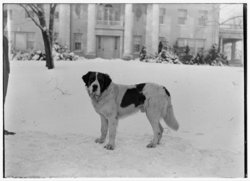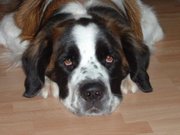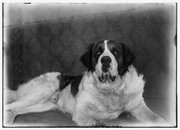
Bernhardiner
Alpine Mastiff
Saint Bernard
|
From Wikipedia the free encyclopedia, by MultiMedia |
| St. Bernard | |
|---|---|

St. Bernard owned by
Wilbur Wright
|
|
| Alternative names | |
| St. Bernhardshund Bernhardiner Alpine Mastiff Saint Bernard |
|
| Country of origin | |
| Switzerland | |
| Common nicknames | |
| Classification and breed standards | |
| FCI: | Group 2 Section 2 #61 |
| AKC: | Working |
| ANKC: | Group 6 (Utility) |
| CKC: | Group 3 - Working Dogs |
| KC (UK): | Working |
| NZKC: | Utility |
| UKC: | Guardian Dogs |
| Not recognized by any major kennel club | |
| This breed of Dog is extinct | |
| Notes | |
|
|
|
 St. Bernard
St. Bernard
The St. Bernard Dog is a large breed of Dog originally bred for rescue and as a working Dog. A full-grown male can weigh between 150 and 200 lb (68 and 90 kg). There are two varieties of the breed: the short-haired or smooth-coat variety and the long-haired or rough-coat variety.
The St. Bernard is known for its loyalty and vigilance and is tolerant of both children and animals. Because of these traits, it has become a family Dog. They also make good watchDogs, as their size can be intimidating to strangers, though their temperament is gentle.
The ancestors of the St. Bernard were the herding Dogs of Swiss farmers as well as hunting Dogs and watchDogs. Their history has also been connected with the hospice at the Great St. Bernard Pass. First reports of the Dogs' presence at the pass date to the 17th century, and they still are loyal companions to the monks there.
The most famous St. Bernard to save people at the pass was Barry (sometimes spelled Berry), who reportedly saved somewhere between 40 and 100 lives. There is a monument to Barry in the Cimetière des Chiens and his body was preserved in the Natural History Museum in Berne[1].
The St. Bernard originally was a smooth-coated Dog developed to rescue travellers from the snow. In the 1830s the monks who owned and bred the Dogs introduced Newfoundland blood to strengthen the breed, and this gave rise to the rough-coat St. Bernard. Although more popular, the rough-coat variety proved to be unsuitable for mountain work because the long hair tended to collect icicles. For this reason the monks kept the smooth coat variety for rescue work.
St. Bernards are very gentle giants. They are extremely fond of children and are loyal to their family, but, as with any Dog, should not be left unsupervised with young children.
 Scipio, a St. Bernard Dog belonging to
Orville Wright
Scipio, a St. Bernard Dog belonging to
Orville Wright
The name "St. Bernard" was not in widespread use until the middle of the 19th century. The Dogs were called "Saint Dogs", "Alpenmastiff", or "Barry Dogs" before, and in parts of North America, they're still called "Saints".
In 1977, Wonderful World of Disney played a TV movie about St. Bernard rescue Dogs, Barry of the Great St. Bernard. Other movies about St. Bernards include Beethoven and Cujo.
St. Bernards are often portrayed, especially in comics and cartoons, with small barrels of brandy worn around their necks. This stems from their use as search Dogs in avalanche rescue efforts in the Alps where the alcohol in the barrel was believed to help warm up rescued victims.
Dogs, made by MultiMedia | Free content and software
This guide is licensed under the GNU Free Documentation License. It uses material from the Wikipedia.